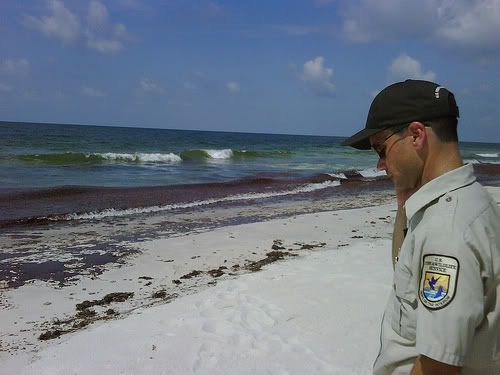
Above: Unified Command Unit assesses the beach after oil disaster.
This week I am grumpy.
Not just a little grumpy…really grumpy.
Why?
Because in the thirty-something years in my career, I still hear the same ol’ sh**, see the same ol’ cr** happening, and wonder why the hell I don’t see big changes.
After all, I got into this field to catalyze change.
I can’t remember what started me on the grump spiral, but after the first thing it quickly began to feel like dominoes.
You know, knock one down and they all begin to fall down one after the other?
It might have started with someone who was passing judgment on another pet owner–a pet owner that lives in a rural area and that has feral cat issues.
A rural pet owner who I passed along information to for feral cat help (Alley Cat Allies) over a year ago but still feeds the cats and allows them to breed and can’t really afford ongoing vet care.
Now, I was pissed off last year because one of the kittens was anemic from flea bite anemia and died. (It was taken to the vet.)
But, the person on the other side of line just got on a high horse and began to rant.
Puh-lease. I am so sick of that.
At least try and help or be understanding but don’t sit in your urban penthouse and talk about something you really know nothing about.
Then, someone who thought they were being helpful, asked me to call someone about their “wolf.”
First, unless someone calls for help–ain’t no sense in going down that road.
Also, if you have read this blog (or have known me for any amount of time) you know that I don’t condone wild or exotic animal pets nor do I believe that wolf-dogs should be bred and sold–which I clearly outline in my wolf-dog series here.
Plus, if it really was a wolf, the person would have to be permitted and inspected by the government agencies that regulate the housing and management of such animals.
If that was not enough, I was then asked if I could again help find a home for a dog whose family never took any time to work with the pup and who decided they no longer want him.
He is an adolescent and not neutered.
Nobody EVER calls and asks if I know of anyone that has a dog they want to rehome.
In the midst of this, my neighbor down the street emailed me to proudly say that they have 10 pups they want to sell–since they bred their dog.
THEN, I stumbled across a series of comments related to why don’t people adopt more pets from shelters…I’ll spare you the details and only say that the rant of a lot of people shows no understanding of what is going on in the pet world at large.
Who the hell gave us the Utopian idea that people would do what they “should” because it is the right thing to do?
I don’t know but they should be shot.
I WANT to believe people will do the right thing…but don’t let me forget to mention the BP fiasco, after two months of idiocy, the oil disaster is still a horrible mess.
In addition to damaging the ocean environment and the multitude of animal and plant life that is suffering–it is posing a threat to the endangered whales in the area.
To rub salt in a wound, this week a few countries were meeting to discuss the brilliant (sarcasm here) idea of starting to allow whaling again.
Eesh.
So why am I so pissed?
There might be a few reasons, but mainly because these are all the same issues that have been going on since I started my career way back in the mid-1970s.
I hear the same ol’ questions, the same poor advice, the same mis-perceptions, and see the same mistakes–over and over again.
What’s a gal to do?
Some things are better–I remember when the euthanasia numbers of pets were more like 20 million a year instead of 4 million a year–but it is still a problem.
But when a local dog got hit by a car this week because the owner believes to dog needs to “be free” instead of confined, it was that last domino falling.
All I can say is that I am mad as hell.
Mad because I keep hoping to see the changes I’ve worked so hard to make happen–but in the end, it seems only like history repeats itself.
*sigh*
So what has changed? Let me know in the comments.
 This is a guest post from animal enthusiast, Susan Long.
This is a guest post from animal enthusiast, Susan Long.
